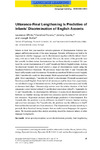Utterance-Final Lengthening Is Predictive of Infants' Discrimination of English Accents
| dc.contributor.author | White, L | |
| dc.contributor.author | Floccia, C | |
| dc.contributor.author | Goslin, J | |
| dc.contributor.author | Butler, J | |
| dc.date.accessioned | 2017-09-18T13:00:59Z | |
| dc.date.available | 2017-09-18T13:00:59Z | |
| dc.date.issued | 2014-09 | |
| dc.identifier.issn | 0023-8333 | |
| dc.identifier.issn | 1467-9922 | |
| dc.identifier.uri | http://hdl.handle.net/10026.1/9946 | |
| dc.description.abstract |
<jats:p>Infants in their first year manifest selective patterns of discrimination between languages and between accents of the same language. Prosodic differences are held to be important in whether languages can be discriminated, together with the infant's familiarity with one or both of the accents heard. However, the nature of the prosodic cues that actually facilitate infant discrimination has not been directly examined. We analyzed the accent discrimination of 5‐ and 7‐month‐old British English infants, looking for durational features that could predict a range of discrimination results using the Headturn Preference Procedure. We previously found that both 5‐ and 7‐month‐olds based in Plymouth could discriminate Plymouth‐accented and Welsh‐accented English, while 5‐month‐olds could not discriminate Welsh‐accented and Scottish‐accented English. Most surprisingly, 7‐month‐olds failed to discriminate Plymouth‐accented and French‐accented English. From half of all utterances used in these four experiments, we calculated a range of durational metrics, both globally across utterances and locally at utterance‐final edges. Utterance‐edge metrics were the relative duration of the final consonant+vowel interval (nfinalCV) and the final vowel alone (nfinalV). Separately for 5‐ and 7‐month‐olds, we determined the difference in scores for all durational metrics between: (a) familiar training and novel test utterances and (b) familiar test and novel test utterances. Regression analyses showed unique predictors of discrimination. For 5‐month‐olds, the predictor was the difference in nfinalCV between familiar training and novel test utterances. For 7‐month‐olds, the predictor was the difference in finalV between familiar test and novel test utterances. This demonstrates an early sensitivity to precisely those localized timing features that are useful across languages for segmentation. We therefore predict that similar sensitivity should be shown in infants of other language backgrounds.</jats:p> | |
| dc.format.extent | 27-44 | |
| dc.language | en | |
| dc.language.iso | en | |
| dc.publisher | Wiley | |
| dc.subject | infant speech perception | |
| dc.subject | accent discrimination | |
| dc.subject | prosody | |
| dc.subject | final lengthening | |
| dc.title | Utterance-Final Lengthening Is Predictive of Infants' Discrimination of English Accents | |
| dc.type | journal-article | |
| dc.type | Article | |
| plymouth.author-url | http://gateway.webofknowledge.com/gateway/Gateway.cgi?GWVersion=2&SrcApp=PARTNER_APP&SrcAuth=LinksAMR&KeyUT=WOS:000341150000004&DestLinkType=FullRecord&DestApp=ALL_WOS&UsrCustomerID=11bb513d99f797142bcfeffcc58ea008 | |
| plymouth.issue | s2 | |
| plymouth.volume | 64 | |
| plymouth.publication-status | Published | |
| plymouth.journal | Language Learning | |
| dc.identifier.doi | 10.1111/lang.12060 | |
| plymouth.organisational-group | /Plymouth | |
| plymouth.organisational-group | /Plymouth/Faculty of Health | |
| plymouth.organisational-group | /Plymouth/Faculty of Health/School of Psychology | |
| plymouth.organisational-group | /Plymouth/REF 2021 Researchers by UoA | |
| plymouth.organisational-group | /Plymouth/REF 2021 Researchers by UoA/UoA04 Psychology, Psychiatry and Neuroscience | |
| plymouth.organisational-group | /Plymouth/REF 2021 Researchers by UoA/UoA04 Psychology, Psychiatry and Neuroscience/UoA04 Psychology, Psychiatry and Neuroscience MANUAL | |
| plymouth.organisational-group | /Plymouth/REF 2021 Researchers by UoA/UoA04 Psychology, Psychiatry and Neuroscience/UoA04 REF peer reviewers | |
| plymouth.organisational-group | /Plymouth/Research Groups | |
| plymouth.organisational-group | /Plymouth/Research Groups/Centre for Brain, Cognition and Behaviour (CBCB) | |
| plymouth.organisational-group | /Plymouth/Research Groups/Centre for Brain, Cognition and Behaviour (CBCB)/Brain | |
| plymouth.organisational-group | /Plymouth/Research Groups/Centre for Brain, Cognition and Behaviour (CBCB)/Cognition | |
| plymouth.organisational-group | /Plymouth/Research Groups/Plymouth Institute of Health and Care Research (PIHR) | |
| plymouth.organisational-group | /Plymouth/Users by role | |
| plymouth.organisational-group | /Plymouth/Users by role/Academics | |
| dcterms.dateAccepted | 2014-04-14 | |
| dc.identifier.eissn | 1467-9922 | |
| dc.rights.embargoperiod | No embargo | |
| rioxxterms.funder | Economic and Social Research Council | |
| rioxxterms.identifier.project | Phonological representations in bidialectal listeners | |
| rioxxterms.versionofrecord | 10.1111/lang.12060 | |
| rioxxterms.licenseref.uri | http://www.rioxx.net/licenses/all-rights-reserved | |
| rioxxterms.licenseref.startdate | 2014-09 | |
| rioxxterms.type | Journal Article/Review | |
| plymouth.funder | Phonological representations in bidialectal listeners::Economic and Social Research Council |


